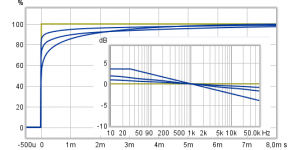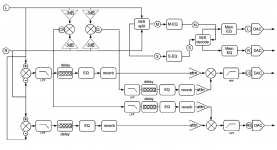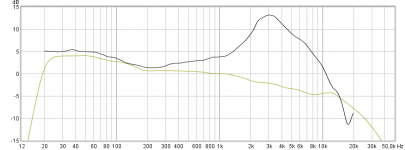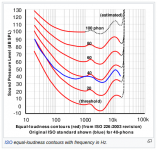Acoustic instruments radiate in various angles depending on the instrument. Put a bunch of different ones together (ie. orchestra) and they radiate in all directions. Just look at the ceiling, back, and side reflectors in a concert hall. The only "absorbers" are the audience 😉
I see no scientific rational for connecting the polar radiation pattern of musical instruments to that of a loudspeaker. One creates the sound while the other reproduces it - they have different jobs.
For example, we want our musical instruments to be richly resonant, but we want the opposite in our playback system. We don't want the playback system to modify the original source of the sound, hence they require completely different design goals.
After measuring the curve I ended up with, it was impossible to deny the resemblance. My biggest deviation from this graph is in the mid/side EQ I use to get the most pleasing tonal balance all trough the stage from left and right compared to the phantom center.
Your approach sounds (pun intended) rational, but I am not clear on what you mean by "mid/side EQ ". And what do you use to EQ your system? The JBL "trained listener" curve is just about identical to my goal as well.
I wonder, when EQing to a non-flat curve, is it a practice to always calibrate playback level to a certain SPL at a specific listening distance? I am thinking that the response should be flat so that you can always calibrate it to a specific SPL then adjust the EQ to based on volume variation and the ear sensitivity curves for different listening levels.
@gedlee My EQ is done with FIR based convolution, based on a (user variable based) frequency dependent window.
The mid/side EQ I use are linear phase EQ tweaks that have an influence on the cross talk perceived in Stereo (well at least if there aren't any early reflections one could perceive this difference).
It consists of subtle tweaks that make a tonal improvement for my setup. Aimed to get equal tonal balance in the phantom center and the separate L and R sides. Most notably it also had improved intelligibility of phantom center voices.
It works even better on Home Theatre material, mixed back to a Stereo signal as I do not have a center channel. It uses the same mid/side tools but with a stronger correction.
Remember the Fixing the Stereo Phantom Center thread from Pano?
I tried all kinds of tweaks while that thread was running (mostly just for fun and learning) and this tweak turned out to be a long term improvement that stuck.
The mid/side EQ I use are linear phase EQ tweaks that have an influence on the cross talk perceived in Stereo (well at least if there aren't any early reflections one could perceive this difference).
It consists of subtle tweaks that make a tonal improvement for my setup. Aimed to get equal tonal balance in the phantom center and the separate L and R sides. Most notably it also had improved intelligibility of phantom center voices.
It works even better on Home Theatre material, mixed back to a Stereo signal as I do not have a center channel. It uses the same mid/side tools but with a stronger correction.
Remember the Fixing the Stereo Phantom Center thread from Pano?
I tried all kinds of tweaks while that thread was running (mostly just for fun and learning) and this tweak turned out to be a long term improvement that stuck.
Last edited:
I remember the "Fixing the center" thread, but I am still unclear on what "mid/side" means? Are these different speakers or what?
And what FIR hardware do you use? I assumed it was an FIR convolution, that much was obvious.
PS. IF I were to do in-room EQ I would do it exactly as you do it. But I don't do in-room EQ. By all accounts it's not totally clear cut which way is best. I suspect that they both yield comparable results when done correctly. Of course < Schroeder, I do use in-room EQ, there are no alternatives there.
And what FIR hardware do you use? I assumed it was an FIR convolution, that much was obvious.
PS. IF I were to do in-room EQ I would do it exactly as you do it. But I don't do in-room EQ. By all accounts it's not totally clear cut which way is best. I suspect that they both yield comparable results when done correctly. Of course < Schroeder, I do use in-room EQ, there are no alternatives there.
Last edited:
Mid/side is where the Stereo signal is split in what's common (phantom) and different (sides). Most EQ tools have this ability, like Fabfilter etc.
The hardware is PC based, a Xeon powered workstation with software (JRiver) convolution.
How it is done is the most important, lots of ways to go wrong with both passive and active. DSP isn't a tool for me to fix the room. I opted to use it to correct my array output, and yes, I do fix the room at bass frequencies with EQ.
While I use DRC-FIR to create the basic FIR correction I do have to adjust afterwards for it's overcorrection, with PEQ tweaks. As soon as one mentions DSP, most people just assume the frequency response gets hammered down to flat. That's not what it's about for me. In fact I don't think that will get us the desired results.
The hardware is PC based, a Xeon powered workstation with software (JRiver) convolution.
How it is done is the most important, lots of ways to go wrong with both passive and active. DSP isn't a tool for me to fix the room. I opted to use it to correct my array output, and yes, I do fix the room at bass frequencies with EQ.
While I use DRC-FIR to create the basic FIR correction I do have to adjust afterwards for it's overcorrection, with PEQ tweaks. As soon as one mentions DSP, most people just assume the frequency response gets hammered down to flat. That's not what it's about for me. In fact I don't think that will get us the desired results.
Last edited:
Yes, I've done that in my Omni project, where I have 2 resonances. It did not improve THD. It did make the FR flat and created min phase and made the IR look better.
Sorry, I see our confusion, I was referring to linear distortions in general, any change in THD would most likely be very small
Mid/side is where the Stereo signal is split in what's common (phantom) and different (sides). Most EQ tools have this ability, like Fabfilter etc.
So Mid/side means the sum and difference of the left and right channels which you EQ differently.
Or is the signal processing sophisticated enough to take out the correlated and uncorrelated signals from the left and right?
The first is trivial, the second somewhat sophisticated.
Last edited:
I wonder, when EQing to a non-flat curve, is it a practice to always calibrate playback level to a certain SPL at a specific listening distance? I am thinking that the response should be flat so that you can always calibrate it to a specific SPL then adjust the EQ to based on volume variation and the ear sensitivity curves for different listening levels.
Agree with wesayso and gedlee about that JBL study curve simply works excellent, they also have it translated to use as a very good sounding head phone target curve seen below. Can see a couple of reasons why it works so good, one is because the declining curve as frq goes up more or less replicate some nature of HF in free air and the other that many studios probably have same response dialed in. In graphs comparing flat verse the declining curve reveal in step or sq-wave response we get a softer attack and a warmer tail whatever XO adds excess phase or not.
Because it sounds so good my own use have become set something close to the JBL curve for speakers and the Harman curve for head phones and thereafter adjust settings for equal loudness (ISO_226-2003) SPL numbers in JRiver player relative to playback level.
Attachments
@BYRTT, if I do recall correctly, that headphone curve you let us listen a few weeks ago wasn't that different, tonally from the in room result of my arrays with the JBL preferred listeners curve applied (and mid/side EQ). At least that was my impression of it.
I still regret the fact that I lost out on getting me one of those OB1 headphones. 🙂
I still regret the fact that I lost out on getting me one of those OB1 headphones. 🙂
Agree it was very close and can say every time i listen same tracks we listened that weekend into head phones here at home reminds me sit into your couch exactly at sweet spot 🙂
since the first sticks and bone flutes
and even after the first trumpet,
clarinet, and twin reverb
I'll give you the sticks as being omnidirectional but none of the others you mentioned are, especially not wind instruments and guitar amps.
If instruments were omnidirectional mic placement when recording would not matter. Just get the mic anywhere in the vicinity of the instrument and you'd be fine.
As it happens correct mic placement is an art and probably the most important aspect of recording. Move one a couple of inches to the sides or up and down and the recording will in most cases sound remarkably different.
A guitar amp like a Fender Twin Reverb is very, very far from omni.
It uses two 12" drivers which are incredibly directional, especially above 1.2k.
Agree with wesayso and gedlee about that JBL study curve simply works excellent, they also have it translated to use as a very good sounding head phone target curve seen below. Can see a couple of reasons why it works so good, one is because the declining curve as frq goes up more or less replicate some nature of HF in free air and the other that many studios probably have same response dialed in. In graphs comparing flat verse the declining curve reveal in step or sq-wave response we get a softer attack and a warmer tail whatever XO adds excess phase or not.
Because it sounds so good my own use have become set something close to the JBL curve for speakers and the Harman curve for head phones and thereafter adjust settings for equal loudness (ISO_226-2003) SPL numbers in JRiver player relative to playback level.
The Harman and JBL curves actually confuse me. If high frequencies attenuate more in air, wouldn’t we want to do the reverse?
Additionally, wouldn’t we want to first measure frequency response of drivers at a design reference SPL, say 85db@3M for a small system, instead of 1M 1W?
I am not saying I disagree with others, but looking at the technical reasoning, the droop in speaker and rise in earphone does not seem to make sense.
Last edited:
Let's not forget that the HF slope interacts with the HF DI. For example a rising DI to a very high DI at the highest frequencies (like a piston source) sounds about right if the axial response is near flat. But take a waveguide with a flat DI that does not rise at the highest frequencies and if it is set to flat on axis then it will sound very bright. And, of course, this is also affected to a certain respect by the rooms absorption.
The Harman and JBL curves actually confuse me. If high frequencies attenuate more in air, wouldn’t we want to do the reverse?...
Think the best argument to use is if many pro's use something more or less close to JBL curve to produce our material then it should bring us closer to their decided mix shouldn't it.
A personal thought and guess about we want to copy HF attenuate scheme from outside nature is because our hearing is never used to from outside hear a theoretical full speed attack for step without some more or less HF attenuate will kick in as in below 3 times blue examples with varying droop verse the gold trace theoretical ideal, and now add than outside in nature HF band is not summed with reflections from any close boundary's and therefor something close to JBL curve is a god target to replicate nature and also filter out a bit of that indoor unnatural HF reflections.

...Additionally, wouldn’t we want to first measure frequency response of drivers at a design reference SPL, say 85db@3M for a small system, instead of 1M 1W?...
Think that's right but not everybody has either the right steered DI or allowed by other family members to treat a living room area to get there and for that case 1 meter is the compromise for response and equal loudness (ISO_226-2003) could be dialed in at 3 meter.
...I am not saying I disagree with others, but looking at the technical reasoning, the droop in speaker and rise in earphone does not seem to make sense.
For that Harman head phone curve they write it replicate how a good speaker target curve will look for a good speaker in a good room, and think tells us that our ears haven't the same response using head phones verse not and guess if we divide those two curves we have what science points out about it if that makes sense why speaker target curve is a droop and head phone target curve is a rise and then a droop.
It just seems that me the engineering basis information is lacking. If the JBL curve were based on fact that most people are not going to calibrate to 85db SPL reference, but lower, then it would make sense.
I can understand that earplug type phones would interact with the canal, but it seems most of these types are for use on stage where the performers need to coordinate in some way, so I would not think those would matter fidelity wise.
I can understand that earplug type phones would interact with the canal, but it seems most of these types are for use on stage where the performers need to coordinate in some way, so I would not think those would matter fidelity wise.
Last edited:
Thanks for the link.Like I said, a touch of warmth noticeable on vocals. Add too much and it will muddy the sound of higher frequencies.
I am of the mind that EQ will be related to DI (as opposed to the default 'flat' response). There is some choice involved in designing the speaker, so I consider this EQ as - prior to preference EQ.
Let's not forget that the HF slope interacts with the HF DI. For example a rising DI to a very high DI at the highest frequencies (like a piston source) sounds about right if the axial response is near flat. But take a waveguide with a flat DI that does not rise at the highest frequencies and if it is set to flat on axis then it will sound very bright. And, of course, this is also affected to a certain respect by the rooms absorption.
+1.
I experienced this first hand when 'voicing' the crossover of my own speakers.
Marco
- Home
- Loudspeakers
- Multi-Way
- Who makes the lowest distortion speaker drivers



